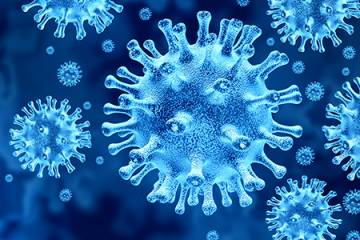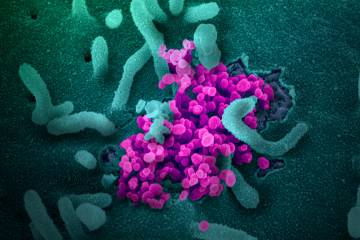How Long Can the Virus Live on Surfaces
How long can the virus that causes COVID-19 live on surfaces?
Carolyn Machamer, a cell biologist who specializes in coronaviruses, discusses the latest research on the virus that causes COVID-19
Co-ordinate to a recent study published in the New England Journal of Medicine, SARS-CoV-2, the virus that causes COVID-xix, can live in the air and on surfaces between several hours and several days. The study found that the virus is viable for upward to 72 hours on plastics, 48 hours on stainless steel, 24 hours on paper-thin, and iv hours on copper. It is too detectable in the air for 3 hours.
Carolyn Machamer, a professor of cell biological science whose lab at the Johns Hopkins School of Medicine has studied the basic biology of coronaviruses for years, joined Johns Hopkins MPH/MBA candidate Samuel Volkin for a brief discussion of these findings and what they mean for efforts to protect confronting spread of the virus. The conversation has been edited for length and clarity.
Volkin: According to this report, information technology sounds like the COVID-xix virus is potentially living on surfaces for days. How worried should we exist nearly our risk of becoming infected simply by touching something an infected person was in contact with days ago?
Machamer: What'southward getting a lot of press and is presented out of context is that the virus tin final on plastic for 72 hours—which sounds actually scary. But what'due south more important is the amount of the virus that remains. It'southward less than 0.ane% of the starting virus cloth. Infection is theoretically possible but unlikely at the levels remaining later on a few days. People need to know this.
While the New England Periodical of Medicine study found that the COVID virus tin can exist detected in the air for iii hours, in nature, respiratory droplets sink to the basis faster than the aerosols produced in this written report. The experimental aerosols used in labs are smaller than what comes out of a cough or sneeze, so they remain in the air at face-level longer than heavier particles would in nature.
What is the best way I can protect myself, knowing that the virus that causes COVID-19 lives on surfaces?
Yous are more likely to catch the infection through the air if you are next to someone infected than off of a surface. Cleaning surfaces with disinfectant or soap is very effective considering one time the oily surface coat of the virus is disabled, at that place is no way the virus can infect a host jail cell. However, at that place cannot be an overabundance of caution. Zero similar this has ever happened before.
The CDC guidelines on how to protect yourself include:
- Make clean and disinfect surfaces that many people come in contact with. These include tables, doorknobs, lite switches, countertops, handles, desks, phones, keyboards, toilets, faucets, and sinks. Avoid touching loftier-contact surfaces in public.
- Wash your hands often with soap and water for at least 20 seconds immediately when you render home from a public place such as the banking concern or grocery store.
- When in a public infinite, put a distance of half-dozen feet between yourself and others.
- Most importantly, stay dwelling house if you are sick and contact your doc.
There has been speculation that once the summertime season arrives and the weather warms up, the virus won't survive, but we don't yet know if that is true. Does the conditions or indoor temperature affect the survival of the COVID-nineteen virus on surfaces?
In that location is no show ane mode or the other. The virus'south viability in exposure to heat or cold has non been studied. But it does conduct pointing out that the New England Journal of Medicine written report was performed at almost room temperature, 21-23 degrees Celsius.
How does the virus that causes COVID-19 compare with other coronaviruses, and why are we seeing so many more cases?
SARS-CoV-2 behaves like a typical respiratory coronavirus in the bones mechanisms of infection and replication. But several mutations allow it to demark tighter to its host receptor and increase its transmissibility, which is thought to arrive more infectious.
The New England Periodical of Medicine study suggests that the stability of SARS-CoV-2 is very like to that of SARS-CoV1, the virus that caused the 2002-2003 SARS global outbreak. But, researchers believe people tin can carry loftier viral loads of the SARS-CoV-two in the upper respiratory tract without recognizing any symptoms, allowing them to shed and transmit the virus while asymptomatic.
Source: https://hub.jhu.edu/2020/03/20/sars-cov-2-survive-on-surfaces/


0 Response to "How Long Can the Virus Live on Surfaces"
Post a Comment